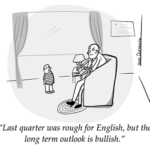
Improving college access and opportunity for students often depends on support and encouragement from educators and communities.
I learned to type in junior high school because my mother believed I needed to learn a skill so I could take care of myself if anything ever happened to my husband. Mom expected me to get married, but she also expected me to graduate from high school, something she had not done. But the idea that I would attend college or have a professional life was the furthest thought from her mind. Ditto for my dad.
Mom was a Rosie the Riveter — one of those women who landed a factory job during World War II when the men were summoned to war and lost that job when they came marching home. She worked long enough to have a taste of what it meant to earn her own paycheck, and she very much wanted her two daughters to have skills they could take into the workplace. In case anything happened to their husbands.
In spite of that, however, no one ever talked to me about college until I switched high schools during my junior year. My new high school was in a midsize Midwestern town with two small colleges and the looming presence of the University of Michigan. I had landed in a community with a college-going culture, new friends who had long planned to go to college, and a core of educators who showed me the path leading there. It was a heady experience to suddenly find that I was a girl with a future bigger than getting married, having babies, and maybe becoming a secretary.
My own story has shown me the difference that school and community attitudes can make in how a student envisions her future.
To enable more students, especially minorities and those from low-income homes, to reach and achieve in college, schools must lay a solid foundation earlier. That means going beyond sloganeering and applying the cosmetics of a college-going culture to a school: naming classrooms after the college attended by the teacher or having students wear the sweatshirts of their favorite colleges on a given day. Nice gestures, but they hardly replace a rigorous curriculum from kindergarten on up that will prepare graduates with the math and writing skills they’ll need to be successful.
As Mesmin Destin and Michael Kosko point out (p. 8), students can be trusted with information about college as early as middle school. “Having conversations with high school students can change a student’s outlook about his or her place in society,” they write. I know that such conversations influenced the trajectory of my life by pointing me to a path I hadn’t previously considered.
Promise scholarship programs, like the El Dorado Promise that Gary Ritter and Jennifer Ash describe (p. 13), offer hope regarding preparation. If these programs only helped pay the bills, they’d be little different from more traditional scholarship programs. What really intrigues and excites me about promise scholarships is how they seem to change teachers’ attitudes. Knowing that every child could attend college alters teacher perceptions and expectations about kids. That is a game changer and the reason why more communities should be experimenting with this exciting new approach.
Early college programs, too, open doors to opportunities that students had not imagined for themselves. By enabling students to see themselves as individuals with potential, many are encouraged to remain in school and aim for a future that includes college. Read Jamal’s story as written by Julie Edmunds (p. 38) to see the dramatic difference that can occur simply by changing a school environment.
In the end, my mother may have been right about learning how to type. Typing has enabled me to take care of myself, although not exactly as she imagined. Her vision for me was limited by the life that she knew and the future that she anticipated. She couldn’t imagine a world in which a woman could thrive as I have. For me, as for so many others, educators, friends, and the broader community are the vital links in connecting students with futures that even many parents cannot see.
Citation: Richardson, J. (2016). The editor’s note: Playing against type. Phi Delta Kappan, 97 (5), 4.
ABOUT THE AUTHOR

Joan Richardson
JOAN RICHARDSON is the former director of the PDK Poll of the Public’s Attitudes Toward the Public Schools and the former editor-in-chief of Phi Delta Kappan magazine.










